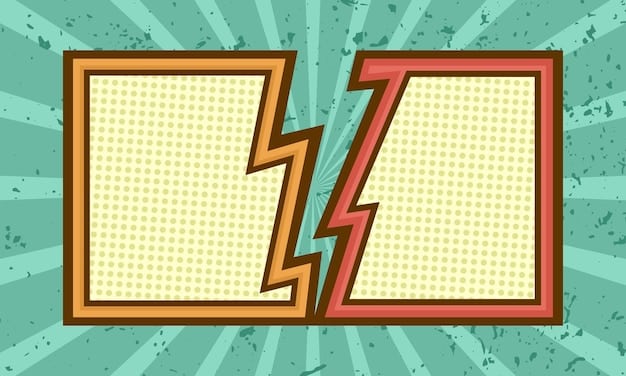Comic Book Restoration: Is It Worth the Financial Investment?

Comic book restoration involves repairing damage to preserve value and improve aesthetics, but whether it’s worth the cost depends on factors like the comic’s rarity, sentimental value, and potential market appreciation.
Is investing in comic book restoration: is it worth the cost? A financial breakdown a wise decision, or is it better to leave vintage comics untouched? The world of comic book collecting is filled with debates, but understanding the economics behind restoration can help collectors make informed choices.
Understanding Comic Book Restoration
Comic book restoration is the process of repairing damage to a comic book to improve its appearance and increase its value. This can range from minor touch-ups to extensive overhauls.
But what exactly does the process entail? And why do collectors consider it?
The Restoration Process
Restoration involves various techniques to address common issues like tears, stains, and fading. Professional restorers use specialized tools and materials to ensure the comic’s integrity is maintained.
Here are some key aspects of the restoration process:
- Cleaning: Removing dirt, dust, and stains without damaging the paper.
- Tear Repair: Mending tears and creases using archival-quality tape or adhesive.
- Color Touch-Up: Adding color to faded areas to restore the original vibrancy.
- Spine Reinforcement: Strengthening the spine to prevent further damage.
Ultimately, the goal is to bring the comic back to as close to its original condition as possible without compromising its historical value.

Understanding the intricacies of restoration is vital for making informed decisions about your comic collection.
Factors Influencing Restoration Costs
The cost of restoring a comic book can vary widely based on several factors. These include the comic’s condition, the extent of the damage, and the restorer’s expertise.
Let’s delve into the specific elements that drive up or down the expenses:
Comic Book Condition
A comic in poor condition will require more extensive work, leading to higher costs. Issues like missing pieces, significant tears, or severe discoloration can significantly increase the restoration price.
Conversely, a comic with only minor flaws might be less expensive to restore, as it requires less time and fewer materials.
Damage Extent
The type and severity of the damage are crucial determinants of cost. For example, a small tear on a non-essential page will be cheaper to fix than a large tear on the cover.
Similarly, water damage, which often leads to mold and paper deterioration, can be particularly costly to address.
Restorer Expertise
Experienced and reputable restorers often charge more for their services. Their expertise ensures that the restoration is done correctly, preserving the comic’s value and preventing further damage.
- Experience: Seasoned restorers have a better understanding of different paper types and restoration techniques.
- Reputation: A well-known restorer with positive reviews can command higher fees.
- Certification: Some restorers have certifications that validate their skills and expertise.
Therefore, paying a premium for a skilled restorer can be a worthwhile investment in the long run.
Comprehending these factors helps collectors budget effectively and choose the right restoration services.
Financial Analysis: Is Restoration a Good Investment?
Deciding whether to restore a comic book requires a careful financial analysis. Consider the potential increase in value versus the cost of restoration.
Evaluate the expected return on investment (ROI) to determine if restoration is financially viable.
Potential Value Increase
Restoration can significantly increase a comic book’s value, especially if it’s rare or highly sought after. A restored comic often commands a higher price in the collector’s market.
Certain key issues, like the first appearance of a popular character, can see substantial value appreciation after restoration.
Cost of Restoration
Obtain quotes from multiple restorers to get an accurate estimate of the restoration cost. Factor in all expenses, including shipping and insurance.
Compare these costs with the potential increase in value to determine the ROI.
ROI Calculation
Calculate the ROI by subtracting the restoration cost from the potential value increase and then dividing by the restoration cost. A positive ROI indicates a profitable investment.
- Formula: ROI = (Value After Restoration – Restoration Cost) / Restoration Cost
- Example: If a comic is worth $1,000 before restoration, $1,500 after restoration, and the restoration cost is $300, the ROI = ($1,500 – $300) / $300 = 4 or 400%.
- Interpretation: An ROI of 400% suggests a very profitable restoration.
Remember that ROI is just one factor to consider. Sentimental value and personal enjoyment also play a role in the decision-making process.
A thorough financial analysis is critical for making an informed decision about comic book restoration.
Risks and Considerations in Comic Restoration
Restoring comic books comes with certain risks. Improper restoration can decrease a comic’s value and authenticity. Choosing the right restoration approach is crucial.
Awareness of these risks helps collectors avoid costly mistakes.
Potential Damage
Inexperienced restorers might use techniques or materials that harm the comic book. This can result in irreversible damage and reduced value.
Always vet potential restorers and ask for references to ensure they have the necessary skills and experience.
Authenticity Concerns
Over-restoration can make a comic book appear inauthentically new, which can deter collectors. Transparent restoration practices are essential for maintaining trust in the market.

Restorers should document the restoration process and disclose all work done on the comic.
Ethical Considerations
Some collectors believe that restoration alters the historical significance of a comic book. Consider these ethical concerns before moving forward with restoration.
- Disclosure: Always disclose whether a comic has been restored when selling or trading it.
- Preservation vs. Restoration: Consider preserving the comic in its current condition rather than restoring it.
Balancing preservation and restoration requires careful thought and ethical considerations.
By understanding these risks, collectors can make informed decisions that protect the value and integrity of their comic books.
Alternative Preservation Methods
Preserving comic books doesn’t always require restoration. Several alternative methods can protect your comics from damage without altering their original state.
Choosing the right preservation method can safeguard your investment and maintain the comic’s authenticity.
Archival Storage
Using archival-quality bags and boards can protect comic books from environmental factors like humidity, light, and dust. These materials are acid-free and designed to prevent deterioration.
Store comics in a cool, dry place away from direct sunlight.
Professional Grading
Submitting comic books to professional grading services like CGC or PGX can protect them in tamper-evident cases. Grading also provides an objective assessment of the comic’s condition.
Graded comics often command higher prices in the collector’s market.
Digital Preservation
Scanning and digitizing comic books can create a backup copy that preserves the content without physically altering the original. This is useful for personal enjoyment and research.
- Scanning: Use a high-resolution scanner to capture all details of the comic book.
- Storage: Store digital copies on multiple devices and in the cloud.
Exploring these alternatives offers valuable ways to maintain comic book collections.
Case Studies: Successful and Unsuccessful Restorations
Examining real-world case studies provides insights into the outcomes of comic book restorations. Understanding both successes and failures can inform your decisions.
These case studies highlight the importance of expertise and careful planning.
Successful Restoration Example
A rare Golden Age comic with significant water damage underwent professional restoration. The restorer carefully repaired the damage, stabilized the paper, and touched up the colors.
The restored comic received a high grade from CGC and sold for a substantial profit at auction.
Unsuccessful Restoration Example
An inexperienced restorer attempted to repair a Silver Age comic with a torn cover. The restorer used improper materials, causing the colors to bleed and the paper to warp.
- Outcome: The comic’s value decreased significantly, and it became difficult to sell.
- Lesson: Always choose a qualified restorer with a proven track record.
These stories underscore the importance of informed decision-making in comic book restoration.
Learning from others’ experiences can help you navigate the restoration process more effectively.
| Key Aspect | Brief Description |
|---|---|
| 💰 Restoration Costs | Varies based on damage and restorer’s expertise. |
| 📈 Value Increase | Potential for higher market value post-restoration. |
| ⚠️ Risks | Potential damage and authenticity concerns. |
| 🛡️ Preservation | Archival storage and digital backups protect comics. |
Frequently Asked Questions
▼
Comic book restoration is the process of repairing and improving the condition of a comic book, addressing issues like tears, stains, and fading to enhance its appearance and value.
▼
The cost varies widely depending on the comic’s condition, the extent of damage, and the restorer’s expertise. Minor repairs might cost $50, while extensive restoration can exceed $500.
▼
It depends on the comic’s rarity, potential value increase, and your personal goals. Evaluate the ROI and consider alternative preservation methods before deciding.
▼
Risks include potential damage from improper techniques, authenticity concerns if over-restored, and ethical considerations about altering the comic’s original state. Choose restorers carefully.
▼
Yes, archival storage using acid-free bags and boards, professional grading and encapsulation, and digital preservation are effective methods to protect and preserve comics without restoration.
Conclusion
In conclusion, determining whether comic book restoration is worth the cost requires careful consideration of financial factors, potential risks, and personal values. By weighing the potential benefits against the expenses and exploring alternative preservation methods, collectors can make informed decisions that best protect their investments and passion for comic books.





